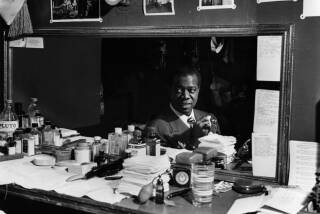From the Archives: Count Basie, 79, Master of Understated Swing, Dies
- Share via
William (Count) Basie, who produced more music with two fingers than most pianists get out of 10, died Thursday in a hospital in Hollywood, Fla., where he had been admitted March 27.
Although Basie, 79, had been undergoing treatment for an ulcer, doctors later determined that he had pancreatic cancer. But the venerable musician-composer-arranger was never told.
“Dad was a very special person,” said Aaron Woodward, his adopted son. “Had he known he had cancer, he would have given up living.”
Except for a couple of years working with a sextet in the early 1950s, when most big bands disintegrated, Basie was never without a full orchestra, exciting audiences with a swinging style that was as relaxed as it was powerful.
The same determination he showed against failing health had kept him on the bandstand from the mid-1930s, when he came storming out of Kansas City, until a few short weeks before his death.
Even a heart attack in 1976, when he was 72, failed to keep him off the bandstand for long. At 77, determined to stay on the road despite ailments, Basie sometimes arrived on stage in a motorized wheelchair. Basie, his band, piano and wheelchair were last seen publicly in Los Angeles in March.
Over the years, the Basie band featured some of the top jazz musicians ever: tenor saxophonists Lester Young, Herschel Evans, Eddie (Lockjaw) Davis, Illinois Jacquet and Paul Gonzalves; altoists Tab Smith and Marshall Royal; trumpet players Buck Clayton, Harry (Sweets) Edison and Thad Jones; drummer Jo Jones and guitarist Freddie Green.
And there were the blues singers who marked the band with their distinctive styles: Jimmy Rushing (“Goin’ to Chicago”) and then Joe Williams (“Every Day”), whom Basie called his “No. 1 son” and who was greatly responsible for the band’s return to popularity after it was reorganized in the 1950s.
Helen Humes and the legendary Billie Holiday also sang with Basie.
First Hit Became Theme
“One O’Clock Jump” was his first big hit and it became his theme. But such arrangers as Benny Carter, Neal Hefti and Quincy Jones kept the band supplied with music that was simply Basie.
Simple was the word. Basie never wanted complex arrangements. “We just play music,” he once said. “And we try to make it swing.”
The Basie band could blow listeners out of their seats with “Red Bank Boogie” or “Jumpin’ at the Woodside,” but it could also have them leaning forward for each delicate note of Hefti’s “Li’l Darlin’.”
What’s more, the musicians always seemed to enjoy themselves.
“What a thrill it was to play with that band,” trumpeter Sweets Edison once said. “It was the greatest thrill of my life. We just couldn’t wait to get on the bandstand at night. It was just like a horse prancing to get out on the race track. We were nervous if we weren’t on the bandstand.”
Edison said he didn’t think there was a better band leader on Earth than Basie, who he called “a very humorous guy” and “easy to get along with.” Basie, he said, knew how to handle men.
Trumpeter Buck Clayton agreed: “He was a leader, all right, but not a harsh one. When someone got too unruly, he (Basie) would eventually get stirred up and let him know he was the boss. He was very nice to work for, but he always knew what he wanted from the band and the arrangers.”
As for Basie’s understated piano style—a touch here and there while the band swung full force—Leonard Feather, The Times’ jazz critic noted in a 1974 review:
“Basie as pianist remains the elliptical master: He plays a sentence, but conveys a paragraph.”
William Basie was born Aug. 21, 1904, in Red Bank, N.J., and his mother taught him to play the piano. He was more interested in beating out rhythm on any handy pot or pan, however, and liked to go to the silent-movie house where he could sit near the pit drummer.
One night, the musicians let him get into the pit and play drums.
At 13, he formed his own band to play for school dances. One day his pianist failed to appear, so Basie took over on that instrument and turned the drums over to his friend Sonny Greer, who later became the drummer for Duke Ellington.
In 1922, Basie went to New York City, where he spent time at the Lincoln Theater hearing Fats Waller play the pipe organ. Waller taught Basie the instrument.
Basie eventually got a job playing piano in a nightclub and finally joined a road show called “Gonsell White and His Big Jamboree Revue.”
That show folded in Kansas City, leaving Basie stranded. He got a job playing piano for a movie house.
But Kansas City was a lively spot for a jazz musician. There were plenty of clubs open all night. Basie joined a black band, Walter Page’s Blue Devils, which blues singer Rushing joined in 1929.
Learned How to Handle Musicians
When Page disbanded, Basie went with the Bennie Moten orchestra, playing back-up piano to Moten and learning from the latter how to handle musicians. Basie said in later years:
“Bennie was my idea of a leader, a real leader. He treated all his men with respect. No temper, no tantrums, just took it easy. You might say he was my model.”
Even before the Moten band disbanded, Basie had formed his own nine-piece group in 1935, picking up drummer Jo Jones from Moten and then hiring the great Lester (Prez) Young, father of the cool tenor sax style.
Basie’s band was playing in a down-at-the heels joint called the Reno Club. The drinks were 15 cents apiece, according to Studs Terkel in “Giants of Jazz,” hamburgers were 5 cents and the musicians earned only $15 a week for seven nights’ work.
But an experimental station carried a nightly broadcast out of the beer garden and jazz critic John Hammond, who had been a big factor in Benny Goodman’s career, picked up the swinging Basie band late one night on his car radio.
He began writing about the band in Down Beat, the jazz magazine, and eventually went to Kansas City with Goodman’s manager, Willard Alexander.
“We don’t try anything fancy.” Basie assured Hammond. “Just something you can pat your foot to.”
For its trek out of Kansas City in October of 1936 to hoped-for prominence in the music world, the band added four pieces, including the durable Freddie Green who stayed with Basie for several decades.
That gave the band its remarkable rhythm section: Basie on piano, Green on guitar, Jo Jones on drums and Walter Page on bass.
The first step was the Grand Terrace in Chicago, but the band had no uniforms or music library, and its instruments were in poor condition. The famed Fletcher Henderson gave Basie a boost by allowing the use of some of his written arrangements.
The band flopped during its appearance at the Hotel William Penn in Pittsburgh, then opened Christmas week of 1936 at the Roseland Ballroom in New York City.
Chill Reception in New York
Its reception was as chilly as the weather. The musicians were depressed. It was Rushing (“Sent For You Yesterday And Here You Come Today”) who urged Basie to keep the band together. He did. Then they cut a record.
It was “One O’Clock Jump,” an immediate smash.
The Basie band was made. Somewhere along the line, a radio announcer decide that William Basie should be “Count” because Ellington was “Duke” and Goodman was the “King of Swing.” “Count” stuck, although Basie allowed that he hated the name.
“I wanted to be called ‘Buck’ or ‘Hoot’ or even ‘Arkansas Fats.’ “
On Thursday, Hammond, speaking on “CBS Morning News,” recalled simply that “Basie just turned out to be a wonderful piano player, a marvelous leader and one of the nicest people in the history of the music business.”
Albert McCarthy, in his book, “Big Band Jazz,” observed that the Basie band brought to New York “a concept of jazz that had been nurtured and developed in the Southwest (Kansas City), with a repertoire heavily based on blues and riff themes, performed with a tremendous swing.”
Many of the numbers, McCarthy wrote, were “loose head arrangements” (unwritten) “that allowed the maximum of freedom to the soloists.”
One of the Basie innovations copied by countless other bands was the placement of the two tenor saxophonists at opposite ends of the reed section, at first presumed by others to have been in the interest of solid sound.
It turned out that Lester Young and Herschel Evans, the first two tenor men who played for Basie, did not care much for each other’s playing and hence were separated by the altos.
Basie went to the small group after World War II but formed a new big band in 1952. He and guitarist Green were the only holdovers. Along came singer Williams (“All Right, Okay, You Win”) to help give the band a new blues sound and push it back into popularity, despite the thin time for bands in general.
A grieving Williams said Thursday, “We have just lost a national treasure but the happiness that his music gave us will live.”
Although some critics viewed postwar Basie as something less than the original, the faithful were as enthusiastic as ever. At the end of a 1975 concert with singer Ella Fitzgerald in Stockholm, the audience applauded and stamped and refused to leave.
Finally, Basie and Fitzgerald had to come back and perform by themselves. The band had long since gone.
Then came the heart attack in 1976 and a succession of other health problems. When he was 76 and had just reassembled his band after hospitalization for a viral infection, Basie appeared at Disneyland, walking with a cane between sets.
Wife Accompanied Him on Road
But Feather wrote: “The musician we saw at the piano was not just the leader of the world’s most durable jazz orchestra; he is a graceful, gentle artist whose music is everything to him and who will not give up his tenure in the only life he knows.”
By that time he was beginning to take a couple of months off between trips to rest at his home in the Bahamas. And his wife, Catherine, who was to die in 1983, was accompanying him on the road.
In 1981, late in his lengthy career, he sat with the President of the United States at a celebration in Kennedy Center where he was honored as one of America’s greatest performing artists.
Ella Fitzgerald sang one of Basie’s favorite songs, “Too Close for Comfort,” in an apropos simple arrangement. President Reagan said the Count was “among the handful of musicians who helped changed the path of American music in the ‘30s and ‘40s. . . .”
Thursday, another prime architect of America’s music, Benny Goodman, agreed:
“He certainly made a notch in musical history.”
From the Archives: Orson Welles, Theatrical Genius, Found Dead at 70
From the Archives: Dr. Bunche, Given Nobel Peace Prize for Work in U.N., Dies
From the Archives: Jazz Great Duke Ellington Dies in New York Hospital at 75
From the Archives: Julie London; Torch Singer, Movie and Television Actress
From the Archives: Ella Fitzgerald, Jazz’s First Lady of Song, Dies
More to Read
Start your day right
Sign up for Essential California for the L.A. Times biggest news, features and recommendations in your inbox six days a week.
You may occasionally receive promotional content from the Los Angeles Times.






